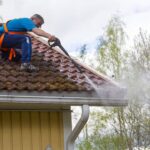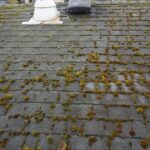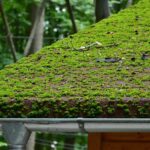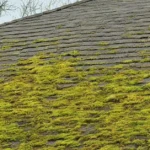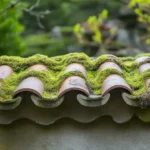Ensuring proper roof water flow is crucial for maintaining the longevity and integrity of your home. A well-maintained roof drainage system prevents water damage, mold growth, and structural issues. If you’re wondering how to improve roof water flow, you’re in the right place. In this article, we’ll explore various techniques and considerations to enhance your roof’s water management system, making your home safer and more efficient.

Understanding the Importance of Roof Water Flow
Roof water flow is not just about directing rainwater away; it’s about protecting your home from potential damage. Inefficient drainage can lead to leaks, water pooling, and even structural damage. By optimizing roof water flow, you safeguard your home against these risks.
Assessing Your Current Roof Drainage System
Before implementing improvements, assess your current system. Look for signs of water pooling, leaks, or visible damage. Regular inspections can help identify issues early. For a comprehensive guide, check out our roof inspection checklist.
Identifying Inefficiencies
Look for clogged gutters, damaged downspouts, or insufficient slope. These are common culprits for poor roof water flow. Addressing these issues can significantly improve water management.
Enhancing Roof Slope and Pitch
A well-designed roof slope is vital for effective water drainage. If your roof’s pitch is inadequate, water may not flow properly, leading to potential damage. Consider consulting a professional to assess and adjust your roof’s slope if necessary.
Correcting Roof Pitch
Adjusting the roof pitch might involve significant renovations, but it’s essential for long-term water flow efficiency. A well-pitched roof ensures that water drains away quickly and effectively.
Maintaining and Cleaning Gutters
Gutter maintenance is a simple yet crucial task in improving roof water flow. Regularly clean gutters and downspouts to prevent blockages. Leaves, debris, and dirt can accumulate, hindering water flow.
DIY Gutter Cleaning Tips
For a step-by-step guide on cleaning and maintaining your gutters, visit our DIY guide. Keeping your gutters clean is a straightforward way to enhance water drainage.
Downspout Considerations
Downspouts play a pivotal role in directing water away from your home’s foundation. Ensure they are clear, properly connected, and extend far enough from the house to prevent water damage.
Repairing Downspouts
If your downspouts are damaged or disconnected, consider repairing them promptly. Our DIY tips can guide you through the repair process.
Installing Roof Drains and Scuppers
For flat or low-slope roofs, installing additional drainage systems like roof drains or scuppers can significantly improve water flow. These systems help in efficiently channeling water away from the roof surface.
Choosing the Right System
Consult with professionals to choose the right drainage system for your roof type. Proper installation is key to ensuring optimal performance and preventing future issues.
Regular Roof Inspections
Conduct regular roof inspections to identify and address potential issues early. Look for signs of water damage, leaks, and structural problems. Early intervention can prevent costly repairs and maintain efficient roof water flow.
Professional Inspections
While DIY inspections are useful, consider hiring professionals for a more thorough assessment. They can identify hidden issues that may not be apparent to an untrained eye.
Addressing Roof Discoloration
Discoloration can indicate underlying water flow issues. Stains and algae growth suggest poor drainage and potential water pooling. Address these issues promptly to maintain a healthy roof.
Fixing Discoloration
For tips on addressing roof discoloration, refer to our guide. Regular maintenance can prevent discoloration and enhance your roof’s appearance.
Utilizing Roof Coatings
Applying roof coatings can improve water resistance and extend your roof’s lifespan. Reflective coatings, in particular, offer additional benefits like reducing heat absorption.
Benefits of Roof Coatings
Learn more about the advantages of roof coatings in our roof coating guide. Proper coating application can significantly enhance your roof’s performance.
Preventing Ice Dams
Ice dams can severely impact roof water flow during colder months. Proper insulation and ventilation are crucial in preventing their formation and ensuring efficient drainage.
Ice Dam Solutions
Consider installing heating cables or improving attic insulation to prevent ice dam formation. These solutions help maintain a smooth water flow, even during winter.
Improving Roof Ventilation
Proper ventilation is essential for maintaining a healthy roof. It prevents moisture buildup and reduces the risk of water-related issues. Ensure your roof has adequate vents for optimal airflow.
Ventilation Tips
Explore our external guide for tips on improving roof ventilation. Good ventilation contributes to better water flow and overall roof health.
Conclusion
Improving roof water flow is essential for safeguarding your home from water damage and enhancing its efficiency. By understanding your current system, maintaining gutters, and considering additional drainage solutions, you can significantly improve your home’s water management. Regular inspections and proactive maintenance are key to ensuring a durable, efficient roofing system.

FAQ
What causes poor roof water flow?
Poor roof water flow can be caused by clogged gutters, insufficient slope, or damaged downspouts. Regular maintenance and proper installation can prevent these issues.
How can I prevent roof leaks?
Regular inspections, gutter cleaning, and ensuring proper roof pitch are effective ways to prevent leaks and maintain efficient roof water flow.
Are roof coatings beneficial?
Yes, roof coatings enhance water resistance and extend your roof’s lifespan. Reflective coatings also reduce heat absorption, offering additional benefits.
This article contains affiliate links. We may earn a commission at no extra cost to you.




